© Use of content without authorization is prohibited

Abruzzo
CHIETI L'AQUILA PESCARA TERAMO
ABRUZZO: Area: 10,828.89 ² Population: 1,269,963 Municipalities: 305 I have been to this region several times. After the first time, I felt the "mal d'Abruzzo," a kind of nostalgia for the beautiful sandy coastline where the sunsets are so romantic... especially along the Costa dei Trabocchi. Then there are the hills rich in medieval villages surrounded by vineyards. No less beautiful are the mountains, the highest in the Apennines, among which the Gran Sasso massif stands out, with the Campo Imperatore area among my favorites. But what I love most about Abruzzo is the wild nature that expresses its best in the Sagittario Valley. This region loves and respects nature, providing refuge to many rare animal and plant species, among which the Marsican Bear stands out. Of Abruzzese cuisine, I enjoyed Spaghetti alla chitarra, Brodetto di pesce, Pallotte cace e ove, and finally the Confetti di Sulmona tasted at the most famous local company. Among the wines, my favorite is Cerasuolo d'Abruzzo in the rosé version.
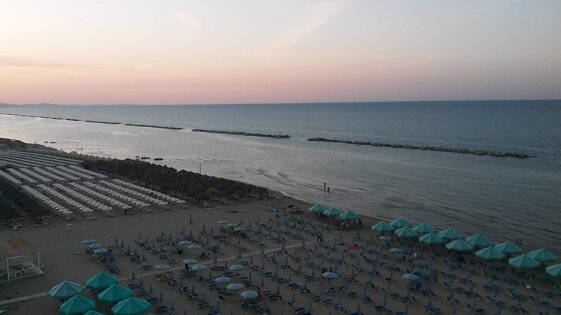
Province of Chieti
Area: 2588.35 km² Population: 371,196 Municipalities: 104
Ortona: Lido Riccio beach
Ortona: Lido Riccio beach
travel stories...



Trabocchi Coast
Crecchio
Ortona
I explored this stretch of coast "only" in the municipalities of Ortona and San Vito Chietino and I noticed the great variety of coastline that, in just a few kilometers, changes from sand to pebbles, to rocks with the presence of these stilt houses that were once used for fishing. Worth mentioning are the little restaurants that prepare mixed fried fish at any hour, also offering takeaway service, fish that I enjoyed in a paper cone while walking along the seafront of San Vito.
This hilly village impressed me with the peace that reigns there. I wandered through this medieval village where numerous cats are the guardians of the beauties it offers, starting from the mighty Ducal Castle, then passing by the Church of the Most Holy Savior, and finally reaching the ancient Church of Santa Maria da Piedi. After passing through its walls, I sat down and in front of me were the unspoiled woods of the Arielli river valley.
Staying in a hotel literally on the beach allowed me to enjoy beautiful sunsets over the Adriatic Sea from the balcony. I visited Ortona several times during the day, strolling around the small port, the lighthouse area, the historic center, and the bustling little streets; but it is a summer night, with the town celebrating along the Passeggiata Orientale and the Aragonese Castle illuminated, that I can never forget...
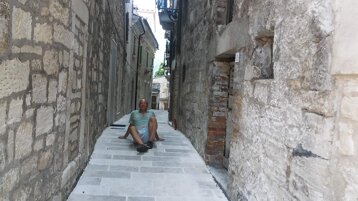

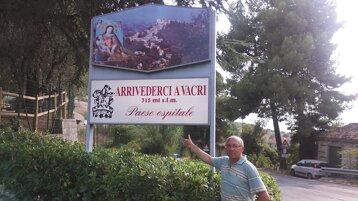
Pennapiedimonte and "La Majelletta"
Guardiagrele
Vacri and the Royal Sheep Track
I spent a pleasant day in this place. The first part was dedicated to visiting the medieval Church dedicated to Santa Maria Maggiore, continuing to the Porta and Torre S. Pietro up to the Municipal Villa with its public gardens and the monument to the Majella Brigade. The second part was dedicated to buying typical local products to give to relatives; in the Town Hall square I found an Infopoint where I was able to buy saffron, oil, and some bottles of local wine, as well as the official t-shirt of the Majella Natural Park.
This country, discovered by chance, struck me for several reasons: its location at the foot of the renowned Majelletta ski resort, which can be reached by a convenient road surrounded by dense forest; back in the village, its houses seem carved into the rock, and some really are; the very narrow and steep streets, so much so that you have to earn the beauty of this village step by step; and finally, the spectacular view from this natural balcony overlooking the Avello river valley all the way to the sea.
Wandering through the hills between the Majella and the sea, I discovered this village with its many churches. The most important is the parish church of San Biagio located in the center of the village. This municipality is crossed by the Royal sheep track L'Aquila-Foggia, which in the past was used by shepherds for transhumance. Today, of all this—and I'm talking about the 1950s—only a few but significant traces remain here; the Church of San Vincenzo, a few shepherds' houses in a district immersed in a rural landscape with vineyards on both sides of the narrow road.

Province of L'Aquila
Area: 5047.55 km² Population: 287,238 Municipalities: 108
Lake Scanno
Lake Scanno
travel stories...
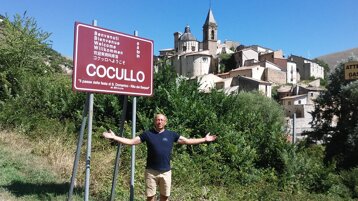

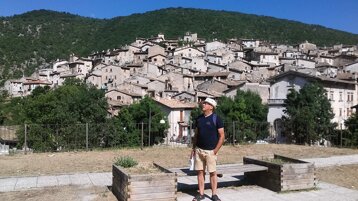
Cocullo
Rocca Calascio
Scanno
During my exploration in the Sagittario Valley, I was able to admire this little gem of just over two hundred souls. At the entrance to the village, where the asphalt gives way to porphyry, you can immediately admire the 13th-century Fountain. Then a maze of narrow streets that always lead to some Church, House, or Gate, evidence of a past rich in history. The highway and "Wind Farm," on the other hand, make the naturalistic part less interesting. I plan to return on May 1st, when the Festival of the Snake Handlers takes place, an event in which pagan rites and religion blend in a ceremony where the main protagonists are the snakes.
Proclaimed by National Geographic as one of the 15 most beautiful castles in the world, Rocca Calascio does not disappoint expectations. Even the road you drive along to reach the village of Calascio is scenic. From there, you continue on foot along a steeply ascending path, passing through the oldest districts of this village, after which you find yourself immersed in a rugged nature whose reward is the Castle. Many films have been shot there, including Lady Hawke, Amici miei, and even some scenes from The Name of the Rose. The Rocca, which dominates the Tirino valley and from which you can admire Campo Imperatore in the background, is bare of furnishings but the charm of these medieval walls is great.
A day here is worth a trip to Abruzzo. I arrived like many others with the illusion of seeing the bear Gemma with her cubs, famous for her raids through the village alleys. Instead, I found a splendid medieval village made up of churches, medieval palaces, ancient fountains, stairways, and hidden corners where in old bakeries they bake sweets to be tasted on the spot. I stocked up on Amaretti, Mostaccioli, Pan dell'Orso, and typical local cookies. Wandering through the flowered alleys with my loot of sweets, it got late and so there was little time left to admire the blue lake surrounded by the green of the Marsicani Mountains; just enough time for a few photos.
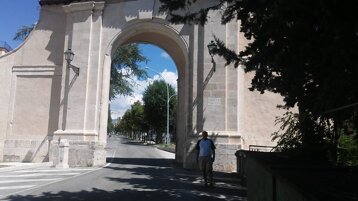


L'Aquila
Sulmona
Anversa degli Abruzzi and the Sagittario Valley
Coming from the hamlet of Bazzano, one of the areas most affected by the 2009 earthquake, I entered through the monumental Porta Napoli; this Arch was faithfully rebuilt after the severe damage caused by the earthquake. From there, along a long tree-lined avenue, you enter the historic center, which is still partly an open-air construction site. Among the most characteristic monuments, I would mention the fountain of the ninety-nine spouts located in the western part of the city; water flows from sculptures representing the 99 castles that founded the city. The spouts are set beneath a beautiful wall covered with white and pink stones arranged in a checkerboard pattern. There is still much to see for a future holiday of a few days.
This important center of the Valle Peligna has dozens of Churches, Palaces, Fountains, Gates, Statues. However, the most striking monument is the Swabian Aqueduct; this medieval architecture divides the historic center in two: on one side the imposing Piazza Garibaldi with its fountain in the center; on the opposite side, past Corso Ovidio, the Church of the Madonna del Carmine. At this point, however, I must confess the reason for my visit: this is a must-stop for food lovers like me. In fact, Sulmona is the world capital of confetti (sugared almonds). I spent pleasant hours at the famous Pelino company, first tasting and then stocking up on various types of confetti to take home. The attached Confetti Museum is also interesting.
Starting from Bugnara, where the valley begins, heading towards Scanno, you come across the village of Anversa degli Abruzzi. Walking through its narrow streets, you reach the Norman Castle made famous by D'Annunzio who, after a visit, set one of his literary works there. Despite the damage caused by several earthquakes, the castle retains great charm. Here, those who wish can take a WWF trail that passes through the village of Castrovalva. Or, as I did, you can drive along the Sagittario Gorges to Lake San Domenico where, if roadside parking allows, you can reach the hermitage via a pedestrian bridge where the blue of the lake, the green of the woods, and the thousand colors of the rocks are a feast for the eyes.
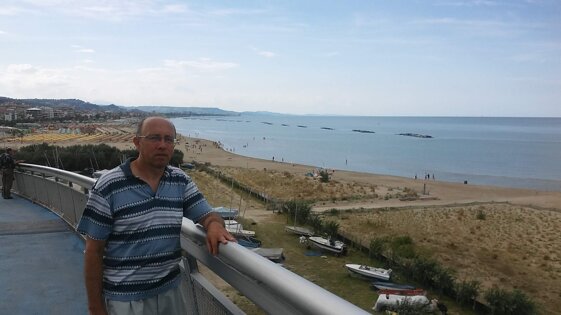
Province of Pescara
Area: 1228.68 km² Population: 312,378 Municipalities: 46
Pescara: the coast seen from the Ponte del Mare
Pescara: the coast seen from the Ponte del Mare
travel stories...

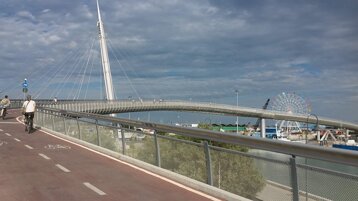
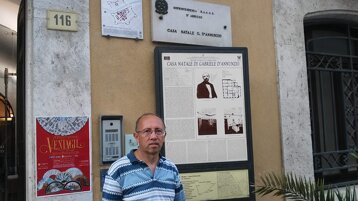
Pescara: the city and its monuments
Pescara: the Ponte del Mare and the beaches
Pescara: the House of D'Annunzio
Parked in the area of the Adriatic Stadium, I begin my tour. First stop is the Aurum, a beautiful building from a century ago, where the liqueur of the same name was once produced, now converted into the "Factory of Ideas" as written at the entrance. I continue inside the Dannunziana Pinewood, an oasis of peace in the middle of the city, up to the Auditorium and then to the seafront. Here, after a short while, I come across a fountain called La Meridiana, which marks the time thanks to a "sundial" placed at the center of the sculpture; a customary photo and then I head towards the Cathedral of San Cetteo, the most important religious architecture in the city; the church's white stone facade is hard to photograph because of the many people crowding the center for an aperitif.
Walking along the seafront coming from Francavilla, you come across this bridge over the Aterno-Pescara River. This architectural work was inaugurated in 2009 and has a pedestrian lane 463 meters long and a bicycle path 442 meters long (as stated on a sign at the end of the bridge). At first, the view is of the port; turning your gaze to the left, you overlook the whole city. But at the top of the bridge, you can admire to the right the long sandy beach, partly free, but mostly occupied by beach resorts. It is the perfect spot to admire the panorama of kilometers of coastline while the breeze coming from the Adriatic stirs the clouds and kisses my face.
Walking around the city, many things recall the poet's name: a bust in the Government Palace, a Pinewood, a Street, several plaques (one on the Sea Bridge dedicated to one of his works entitled Water), even the university. But it is by walking along the historic Corso Manthonè that you find the house of Gabriele D'Annunzio. He was born here on March 12, 1867, and in this beautiful house he received his first lessons in grammar and French from private tutors. The building, dating from the eighteenth century, has been restored several times, both before and after D'Annunzio's death. Today it has become a House Museum where furnishings, clothes, books, paintings, letters, and various memorabilia are preserved that tell the story of the poet's life.
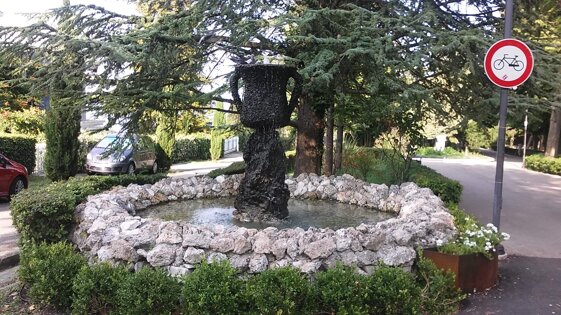
Province of Teramo
Area: 1954.73 km² Population: 299,151 Municipalities: 47
Atri: fountain at the entrance of the municipal park
Atri: fountain at the entrance of the municipal park
travel stories...
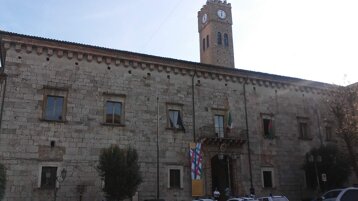
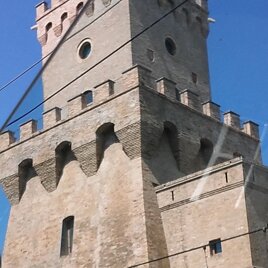
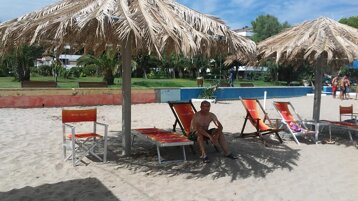
Atri
Silvi and its beaches
Pineto and the Tower of Cerrano
While on vacation on the Abruzzo coast, I dedicated a day to this interesting town in the Teramo hills. After parking near the municipal park and stocking up on brochures at the nearby infopoint, I headed towards that wonderful porphyry square that is Piazza Duomo, where in order I was able to admire: the Church of Santa Reparata erected in honor of the martyr of Caesarea, then the Basilica of Santa Maria Assunta built in Romanesque-Gothic style, and finally the Municipal Theater which features beautiful decorations on the vault of the facade. I continued to the Church of San Francesco up to the medieval Palazzo dei Duchi D'Acquaviva, now the town hall. Arriving at the northern walls of the village, the Belvedere opens up before my eyes with a view also of the Calanchi Nature Reserve, geological formations created by water. A few minutes to buy the renowned licorice of Atri and then off I went.
I spent a pleasant week in August in the hamlet of Silvi Marina. The town does not have any noteworthy civil or religious architecture. Its main attraction is the sea and everything that revolves around it. Here the beaches are wide, with soft golden sand; in this case, I preferred the beach club to the free beach, because for a reasonable price you can enjoy all the services. The sea was clean and the water shallow for dozens of meters. Every evening in the square there were free shows; among my favorites: ballroom dancing, open-air cinema, the Summerfest with street artists and the show inspired by Frozen the Snow Queen, the Tiromancino concert, and on Ferragosto the fireworks over the water. After sending a few postcards and having one last dinner on the seafront, this adventure too is now a sweet memory.
This seaside town with a modern feel concentrates its two main architectural works along Viale D'Annunzio: the parish church dedicated to Saint Agnes and Saint Sylvester; and Villa Filiani, a historic building with a well-kept garden open to the public right in the center; today the villa hosts, among others, the Ethnomusicological Museum and in summer it is also open in the evening. But for a nature lover like me, the strong point of Pineto is that instead of a seafront promenade, it has a pine forest that separates the city from the sea; it was pleasant to walk in the shade of the different species of pine trees all the way to the splendid Torre del Cerrano; this tower is just a few meters from the beach, beautiful and wild like few others on the Teramo Adriatic coast.